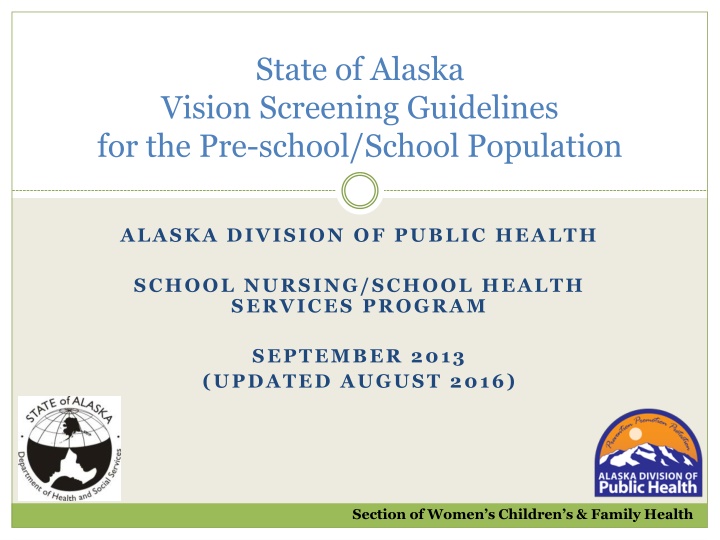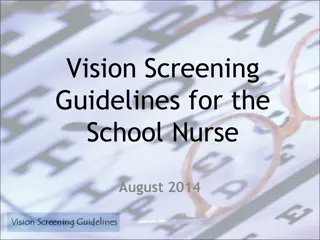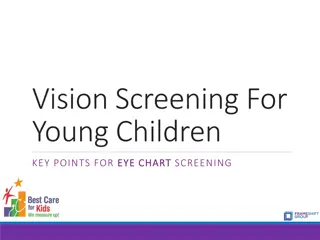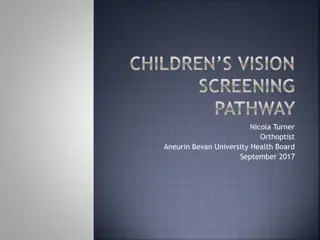Alaska Vision Screening Guidelines for School Children
Learn about the State of Alaska's vision screening guidelines for the pre-school and school population, including recommended tests, equipment, procedures, and referral criteria. Discover the importance of screening for vision problems like amblyopia, the leading cause of childhood blindness. Understand the objectives of school vision screening, state law requirements, and best practices for identifying and addressing vision abnormalities in children.
Download Presentation

Please find below an Image/Link to download the presentation.
The content on the website is provided AS IS for your information and personal use only. It may not be sold, licensed, or shared on other websites without obtaining consent from the author.If you encounter any issues during the download, it is possible that the publisher has removed the file from their server.
You are allowed to download the files provided on this website for personal or commercial use, subject to the condition that they are used lawfully. All files are the property of their respective owners.
The content on the website is provided AS IS for your information and personal use only. It may not be sold, licensed, or shared on other websites without obtaining consent from the author.
E N D
Presentation Transcript
State of Alaska Vision Screening Guidelines for the Pre-school/School Population ALASKA DIVISION OF PUBLIC HEALTH SCHOOL NURSING/SCHOOL HEALTH SERVICES PROGRAM SEPTEMBER 2013 (UPDATED AUGUST 2016) Section of Women s Children s & Family Health
Objectives At the end of this presentation the participant will be able to: List the recommended tests for vision screening based on the State of Alaska Vision Screening Guidelines for the Pre-school/School Population. Identify up-to-date and age-appropriate vision screening equipment. Articulate vision screening procedures for the recommended tests including referral criteria. Section of Women s Children s & Family Health
Why screen for vision problems? Amblyopia is the leading cause of childhood blindness. The condition is reversible if caught early and treated. Section of Women s Children s & Family Health
Screening & Referral Referral for further evaluation Screening Section of Women s Children s & Family Health
Objectives of School Vision Screening Identify children with vision abnormalities or risk factors. Establish follow up procedures to assist in receiving care. Notify parents of results and facilitate referrals. Inform teachers of classroom recommend- ations. Section of Women s Children s & Family Health
What does State Law say? Alaska State Law Sec. 14.30.127. Vision and hearing screening examinations. A vision and hearing screening examination shall be given to each child attending school in the state. The examination shall be made when the child enters school or as soon thereafter as is practicable, and at regular intervals specified by regulation by the governing body of the district. http://www.legis.state.ak.us/basis/folio.asp Section of Women s Children s & Family Health
State of Alaska Vision Screening Guidelines for the Pre-school/School Population Section of Women s Children s & Family Health
Best Practice Section of Women s Children s & Family Health
Background Information REVIEW OF KNOWLEDGE Section of Women s Children s & Family Health
Eye Anatomy and Function Section of Women s Children s & Family Health
Visual Acuity Visual acuity refers to the sharpness of one s eyesight. Acuity is reported in a fraction. Numerator = distance from the chart Denominator = size of the symbol the person can see at 20 feet Example 20/40 means the person must be as close as 20 feet to see what a person with normal vision can see at 40 feet. Section of Women s Children s & Family Health
Normal Visual Functions Distance Vision distance acuity (ability to see images at a distance) Near vision near point acuity (ability to see objects with clarity at close range) Color Vision ability to perceive and distinguish color Binocular vision ability for both eyes to work together simultaneously to focus on the same object Peripheral vision side vision; what is seen from the side when looking straight ahead Ocular motility ability of the eyes to move together in all directions. Section of Women s Children s & Family Health
Childhood Vision Disorders Condition Negative Impact Intervention Myopia Blurry distance vision Impacts learning from distance targets Glasses Contact lenses Hyperopia Blurry near vision Eye strain Difficulty reading Glasses Contact lenses Astigmatism Partial blurring at distance and near Poor school performance Glasses Contact lenses Strabismus Unequal image clarity Significant impact on learning and quality of life Glasses Surgery Eye patching or eye drops Amblyopia Permanent disruption of fusion and depth perception Significant impact on learning and quality of life Glasses Surgery Eye patching or eye drops Section of Women s Children s & Family Health
Myopia The most common of refractive errors, nearsightedness is the inability to see clearly at a distance. Section of Women s Children s & Family Health
Hyperopia Farsightedness is a refractive error in which the light rays from an incoming visual image have not converged by the time they reach the retina. Section of Women s Children s & Family Health
Astigmatism A refractive error in which light rays entering the eye through the corneal surface are distorted and do not focus on a single point but instead focus on two or more points resulting in blurred vision. Section of Women s Children s & Family Health
Strabismus A deviation of one or both eyes from the visual axis so they are not simultaneously directed to the same object. Also referred to as heterotropia or tropia. Section of Women s Children s & Family Health
Amblyopia A dysfunction of visual processing resulting from degradation of the retinal image, usually unilateral. Caused by strabismus, high bilateral hyperopia, anisometropia (when the two eyes have markedly different refractive powers) or deprivation/occlusion. Leading cause of preventable vision loss in children. Section of Women s Children s & Family Health
Amblyopia Normal eye Amblyopic eye Section of Women s Children s & Family Health
State of Alaska Vision Screening Guidelines for the Pre-school/School Population REVIEW OF RECOMMENDATIONS Section of Women s Children s & Family Health
Objectives 1.Distance Acuity 2. Stereovision 3. Ocular Alignment 4. Photoscreening Section of Women s Children s & Family Health
Distance Vision: When to Screen Grades: preschool kindergarten 1st, 3rd, 5th, 7th, 10th, 12th Regardless of grade, screen students upon: initial entry in the school district entrance into special education and with follow up evaluations grade repetition request of teacher, parent, or healthcare provider evidence of known risk factors Section of Women s Children s & Family Health
Risk Factors History Positive Risk Assessment -Very low birth weight (< 1500 gm) -Preterm birth (< 33 weeks gestation) Perinatal History -Metabolic diseases (ex. diabetes) -Eye disorders (preschool or early childhood use of glasses in parents or siblings); congenital cataracts, retinoblastoma, genetic diseases Family History -Concerns how the child sees -Special needs (develop delay, neurologic) -Obvious problems (eye crossing, drifting, drooping) -Diseases/syndromes Health History Section of Women s Children s & Family Health
Binocular Vision: When to Screen Stereoacuity and ocular alignment Administered at least once to children between the ages of 3 and 6 (preschool, kindergarten, or first grade) or upon entry into the school district. Photoscreening Administered at least once to children between the ages of 3 and 5 (preschool or kindergarten) and utilized for the special needs population. Section of Women s Children s & Family Health
Objectives 1.Distance Acuity 2. Stereovision 3. Ocular Alignment 4. Photoscreening Section of Women s Children s & Family Health
Objectives Distance Visual Acuity - HOTV -Lea Symbols -Sloan Section of Women s Children s & Family Health
Wait, wait, dont tell me . . . Which of these charts is appropriate for screening a 5 year old child? D B A C Section of Women s Children s & Family Health
Distance Visual Acuity Equipment Lea Symbols Section of Women s Children s & Family Health
Distance Visual Acuity Equipment Sloan Section of Women s Children s & Family Health
Distance Visual Acuity Equipment Occluders Right and left occlusion spectacle frames Paper patch Traditional monocular handheld occluder Binocular pinhole occluder Section of Women s Children s & Family Health
Objectives: Distance Visual Acuity Procedures Referral Criteria Section of Women s Children s & Family Health
Objectives: Distance Visual Acuity Orienting/preparing the child . . . Section of Women s Children s & Family Health
Articulate Vision Screening Procedures DISTANCE VISUAL ACUITY SCREENING Occluder over left eye Start at 20/50 line and work up or down Ask to read line of letters or symbols; do not cover optotypes Record the line number of last line read correctly (75%) Occlude right eye and repeat procedure. Section of Women s Children s & Family Health
Articulate Vision Screening Procedures Pass Criteria Number of optotypes in the row 1- 3 #Number of misses allowed 0 25% 4 - 7 1 75% 8 - 11 2 Section of Women s Children s & Family Health
Objectives Articulate Referral Criteria 3, 4, 5 Years of Age 6 Years & Older Worse than 20/40 Worse than 20/30 Or, 2-Line or more difference between each eye Section of Women s Children s & Family Health
Wait, wait, dont tell me . . . 5 year old child results: Right eye 20/30 Left eye 20/40 Is this a referral? Yes or No 1. 6 year old child results: Right eye 20/30 Left eye 20/40 2. Is this a referral ? Yes or No 8 year old child results: Right eye 20/20 Left eye 20/30 3. Is this a referral? Yes or No Section of Women s Children s & Family Health
Objectives 1.Distance Acuity 2. Stereovision 3. Ocular Alignment 4. Photoscreening Section of Women s Children s & Family Health
Objectives 1.Distance Acuity 2. Stereovision 3. Ocular Alignment 4. Photoscreening Section of Women s Children s & Family Health
Objectives: Stereoacuity - Stereo Fly or Butterfly -Random Dot E Section of Women s Children s & Family Health
Stereoacuity Equipment Binocular Vision Screening -Stereoacuity Random Dot E Stereo Fly Section of Women s Children s & Family Health
Objectives: Stereoacuity Procedures Referral Criteria Section of Women s Children s & Family Health
Objectives: Stereo Fly/Butterfly Orienting/preparing the child . . . 1. Where do you locate yourself when presenting the stereo fly or butterfly booklet to the child? 2. Do you remove prescription glasses if the child wears them when placing the polarized glasses on the child? Section of Women s Children s & Family Health
Wait, wait, dont tell me . . . Stereo Test Animals Test Correct Answers A Cat B Rabbit C Monkey Section of Women s Children s & Family Health
Random Dot E Orienting/preparing the child . . . 1. Where do you locate yourself when presenting the Random Dot E test to the child? 2. Do you remove prescription glasses if the child wears them when placing the polarized glasses on the child? 3. At what distance and how many times should you practice using the demo E card with the student? Section of Women s Children s & Family Health
Articulate Vision Screening Procedures Random Dot E 20 inches away at eye level Present 2 test cards 5 times Mix behind back between 40 inches away and repeat Wait, wait don t tell me Results of screening: 20 inches - the child gets 4 out of the 5 correct 40 inches the child gets 3 out of 5 correct Do the results of this screening constitute a referral? Section of Women s Children s & Family Health
Objectives 1.Distance Acuity 2. Stereovision 3. Ocular Alignment 4. Photoscreening Section of Women s Children s & Family Health
Objectives Ocular Alignment - Occluder -Penlight -Fixation Target Section of Women s Children s & Family Health
Ocular Alignment Equipment Binocular Vision Screening Ocular Alignment Fixation Target Occluder Penlight Section of Women s Children s & Family Health
Objectives: Ocular Alignment Procedures Referral Criteria Section of Women s Children s & Family Health
Objectives: Hirschberg Test Orienting/preparing the child . . . 1. How should the child be located in relation to the screener when performing the Hirschberg or Corneal Light Reflex Test? 2. Do you remove prescription glasses if the child wears them? Section of Women s Children s & Family Health























